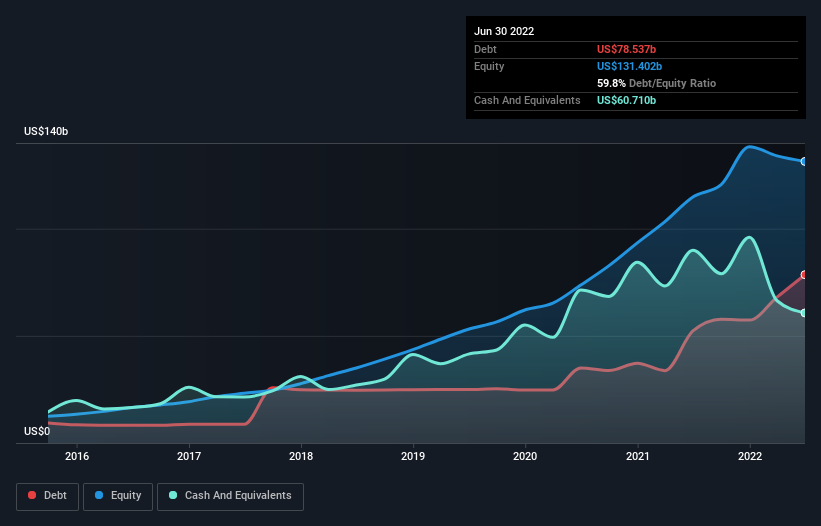- United States
- /
- General Merchandise and Department Stores
- /
- NasdaqGS:AMZN
Is Amazon.com (NASDAQ:AMZN) Using Too Much Debt?
Howard Marks put it nicely when he said that, rather than worrying about share price volatility, 'The possibility of permanent loss is the risk I worry about... and every practical investor I know worries about.' When we think about how risky a company is, we always like to look at its use of debt, since debt overload can lead to ruin. We can see that Amazon.com, Inc. (NASDAQ:AMZN) does use debt in its business. But is this debt a concern to shareholders?
Why Does Debt Bring Risk?
Debt is a tool to help businesses grow, but if a business is incapable of paying off its lenders, then it exists at their mercy. In the worst case scenario, a company can go bankrupt if it cannot pay its creditors. However, a more common (but still painful) scenario is that it has to raise new equity capital at a low price, thus permanently diluting shareholders. Of course, plenty of companies use debt to fund growth, without any negative consequences. When we examine debt levels, we first consider both cash and debt levels, together.
View our latest analysis for Amazon.com
What Is Amazon.com's Debt?
The image below, which you can click on for greater detail, shows that at June 2022 Amazon.com had debt of US$78.5b, up from US$52.3b in one year. However, because it has a cash reserve of US$60.7b, its net debt is less, at about US$17.8b.

A Look At Amazon.com's Liabilities
The latest balance sheet data shows that Amazon.com had liabilities of US$140.3b due within a year, and liabilities of US$148.0b falling due after that. On the other hand, it had cash of US$60.7b and US$34.6b worth of receivables due within a year. So its liabilities total US$193.0b more than the combination of its cash and short-term receivables.
Of course, Amazon.com has a titanic market capitalization of US$1.31t, so these liabilities are probably manageable. But there are sufficient liabilities that we would certainly recommend shareholders continue to monitor the balance sheet, going forward. Carrying virtually no net debt, Amazon.com has a very light debt load indeed.
We measure a company's debt load relative to its earnings power by looking at its net debt divided by its earnings before interest, tax, depreciation, and amortization (EBITDA) and by calculating how easily its earnings before interest and tax (EBIT) cover its interest expense (interest cover). The advantage of this approach is that we take into account both the absolute quantum of debt (with net debt to EBITDA) and the actual interest expenses associated with that debt (with its interest cover ratio).
Amazon.com's net debt is only 0.34 times its EBITDA. And its EBIT covers its interest expense a whopping 10.0 times over. So we're pretty relaxed about its super-conservative use of debt. The modesty of its debt load may become crucial for Amazon.com if management cannot prevent a repeat of the 48% cut to EBIT over the last year. When a company sees its earnings tank, it can sometimes find its relationships with its lenders turn sour. The balance sheet is clearly the area to focus on when you are analysing debt. But it is future earnings, more than anything, that will determine Amazon.com's ability to maintain a healthy balance sheet going forward. So if you're focused on the future you can check out this free report showing analyst profit forecasts.
Finally, while the tax-man may adore accounting profits, lenders only accept cold hard cash. So we clearly need to look at whether that EBIT is leading to corresponding free cash flow. Over the last three years, Amazon.com reported free cash flow worth 6.9% of its EBIT, which is really quite low. For us, cash conversion that low sparks a little paranoia about is ability to extinguish debt.
Our View
Amazon.com's EBIT growth rate was a real negative on this analysis, although the other factors we considered cast it in a significantly better light. For example its net debt to EBITDA was refreshing. We think that Amazon.com's debt does make it a bit risky, after considering the aforementioned data points together. Not all risk is bad, as it can boost share price returns if it pays off, but this debt risk is worth keeping in mind. When analysing debt levels, the balance sheet is the obvious place to start. However, not all investment risk resides within the balance sheet - far from it. Case in point: We've spotted 2 warning signs for Amazon.com you should be aware of, and 1 of them is a bit concerning.
If you're interested in investing in businesses that can grow profits without the burden of debt, then check out this free list of growing businesses that have net cash on the balance sheet.
The New Payments ETF Is Live on NASDAQ:
Money is moving to real-time rails, and a newly listed ETF now gives investors direct exposure. Fast settlement. Institutional custody. Simple access.
Explore how this launch could reshape portfolios
Sponsored ContentNew: Manage All Your Stock Portfolios in One Place
We've created the ultimate portfolio companion for stock investors, and it's free.
• Connect an unlimited number of Portfolios and see your total in one currency
• Be alerted to new Warning Signs or Risks via email or mobile
• Track the Fair Value of your stocks
Have feedback on this article? Concerned about the content? Get in touch with us directly. Alternatively, email editorial-team (at) simplywallst.com.
This article by Simply Wall St is general in nature. We provide commentary based on historical data and analyst forecasts only using an unbiased methodology and our articles are not intended to be financial advice. It does not constitute a recommendation to buy or sell any stock, and does not take account of your objectives, or your financial situation. We aim to bring you long-term focused analysis driven by fundamental data. Note that our analysis may not factor in the latest price-sensitive company announcements or qualitative material. Simply Wall St has no position in any stocks mentioned.
About NasdaqGS:AMZN
Amazon.com
Engages in the retail sale of consumer products, advertising, and subscriptions service through online and physical stores in North America and internationally.
Flawless balance sheet and undervalued.
Similar Companies
Market Insights
Weekly Picks

Early mover in a fast growing industry. Likely to experience share price volatility as they scale


A case for CA$31.80 (undiluted), aka 8,616% upside from CA$0.37 (an 86 bagger!).


Moderation and Stabilisation: HOLD: Fair Price based on a 4-year Cycle is $12.08
Recently Updated Narratives

Meta’s Bold Bet on AI Pays Off

ADP Stock: Solid Fundamentals, But AI Investments Test Its Margin Resilience

Visa Stock: The Toll Booth at the Center of Global Commerce
Popular Narratives


Crazy Undervalued 42 Baggers Silver Play (Active & Running Mine)


NVDA: Expanding AI Demand Will Drive Major Data Center Investments Through 2026


A case for CA$31.80 (undiluted), aka 8,616% upside from CA$0.37 (an 86 bagger!).
Trending Discussion

AMC will prove to be BBBY 2.0 before it's all done. Life has become too expensive for people (especially those with children) to afford movie theater experiences regularly. If you add for the even higher ticket prices of "specialty" theaters with the luxury seating and XL/3D screens, it becomes even MORE unaffordable. This becomes just plain comical when additionally factoring in the unreasonably high priced snacks & drinks. The average family has been priced out of "movie nights". More and more people have instead, saved up to buy ever larger TVs, (which have become much more affordable in resent years) in order to stretch their money and remain on budget throughout their movie watching. With a substantially larger TV, it feels a bit more similar to the "big screen" experience of a movie theater. As time goes on, the theater ONLY experience will be reserved for those special releases that have been anxiously waited on and are expected to be EXTREME and INTENSE! The mere lack of affordability will make movie going, a growingly rare occasion for an increasing number of people. Although the theater is a favorite pastime, facts ARE facts. This particular source of entertainment, has become too budget busting, year over year for the average consumer. I, quite frankly, see this problem only growing worse in the future.



